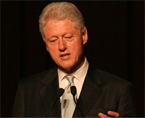its scientific councils, committees and research units.The Academy was also involved in founding the Rudjer Bošković Institute in 1949.
The Rudjer Bošković Institute is Croatia's biggest research institute where I did for forty years research on reactions and properties of molecules in the gas-phase as well as in atmospheric chemistry leading to the projects I report here. The Institute was the Croatian partner in the projects which were catalyzed by the memberships of both sides investigators in IUPAC.
The International Union for Pure and Applied Chemistry was formed in 1919 by chemists from industry and academia in 1919 and is now an umbrella organization of the world chemists and Adhering Chemical Societies who delegate members to its Divisions and bodies.
The 12 members of the Commision for Atmospheric Chemistry who attended the IUPAC General Assembly in Lissabon 1993 and helped to organize the Workshop on Atmospheric problems in developing countries at Chengde in 1994, are shown here with (among others) its proposed host Prof Tang (Beijing) and Prof Slanina (NL) the Commision President.
Here I show the Announcement of the Chengde Workshop and our contribution:
(INTERNATIONAL UNION OF PURE AND APPLIED CHEMISTRY
COMMISSION ON ATMOSPHERIC CHEMISTRY
CENTER FOR ENVIRONMENTAL SCIENCE, PEKING UNIVERSITY
LOCAL AIR POLLUTION IN FAST DEVELOPING COUNTRIES
Cheng De, 20-21 July 1994.
TROPOSPHERIC OZONE MEASUREMENTS IN CROATIA
T. Cvitas, N. Kezele, L. Klasinc and I. Lisac
Pure Appl. Chem.67,1995,1450)
In our contribution we reported ozone measurement results from the end of XIX century in Zagreb and compared them with recent ones which showed them now more than doubled. We also suggested there the use of an “ozone indicator” based on the average of daily maximum-to-minimum ratios over the plant growth period to analyze photochemical pollution and make site comparisons.
We published a paper on this approach in Env.MonitAssess.165






